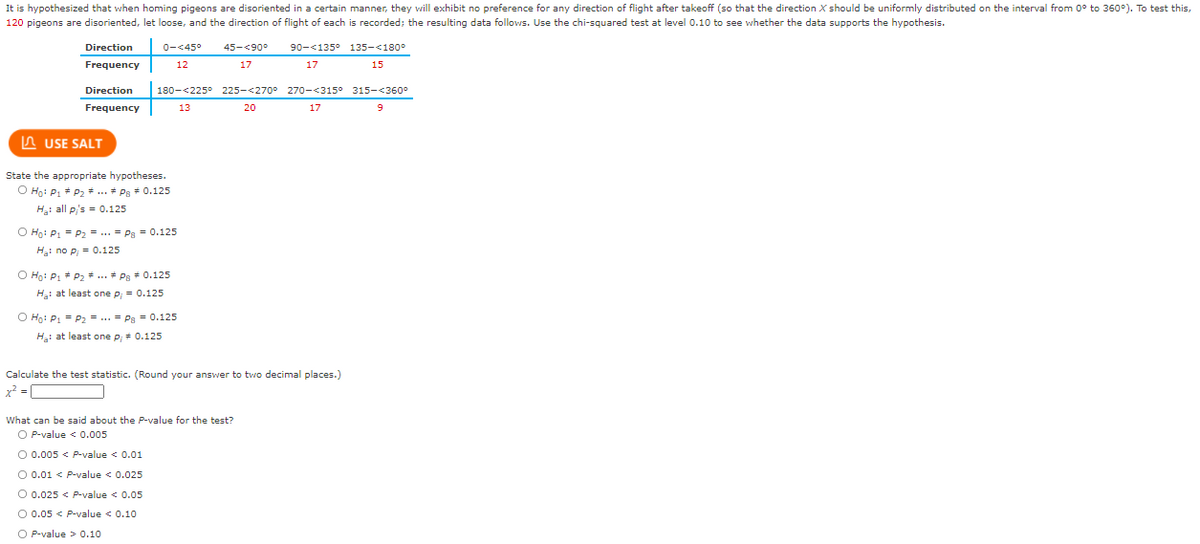It is hypothesized that when homing pigeons are disoriented in a certain manner, they will exhibit no preference for any direction of flight after takeoff (so that the direction X should be uniformly distributed on the interval from 0° to 360°). To test this, 120 pigeons are disoriented, let loose, and the direction of flight of each is recorded; the resulting data follows. Use the chi-squared test at level 0.10 to see whether the data supports the hypothesis. Direction 0-<45° 45-<900 90-<135° 135-<180° Frequency 12 17 17 15 | 180-<225° 225-<270° 270-<315° 315-<360° Direction Frequency 13 20 17 A USE SALT State the appropriate hypotheses. O Ho: P: * P2 * ... * Pg * 0.125 H all p's = 0.125 O Họ: P, = P2 = ... = Pa = 0.125 H: no p- 0.125 O Ho: P * P2 .. * Pa * 0.125 H: at least one p- 0.125 O Ho: P - P2 -.." Pa-0.125 H: at least one p 0.125 Calculate the test statistic. (Round your answer to two decimal places.) What can be said about the P-value for the test? O P-value < 0.005 O 0.005 < Pvalue < 0.01 O 0.01 < P-value < 0.025 O 0.025 < P-value < 0.05 O 0.05 < P-value < 0.10 O P-value > 0.10
It is hypothesized that when homing pigeons are disoriented in a certain manner, they will exhibit no preference for any direction of flight after takeoff (so that the direction X should be uniformly distributed on the interval from 0° to 360°). To test this, 120 pigeons are disoriented, let loose, and the direction of flight of each is recorded; the resulting data follows. Use the chi-squared test at level 0.10 to see whether the data supports the hypothesis. Direction 0-<45° 45-<900 90-<135° 135-<180° Frequency 12 17 17 15 | 180-<225° 225-<270° 270-<315° 315-<360° Direction Frequency 13 20 17 A USE SALT State the appropriate hypotheses. O Ho: P: * P2 * ... * Pg * 0.125 H all p's = 0.125 O Họ: P, = P2 = ... = Pa = 0.125 H: no p- 0.125 O Ho: P * P2 .. * Pa * 0.125 H: at least one p- 0.125 O Ho: P - P2 -.." Pa-0.125 H: at least one p 0.125 Calculate the test statistic. (Round your answer to two decimal places.) What can be said about the P-value for the test? O P-value < 0.005 O 0.005 < Pvalue < 0.01 O 0.01 < P-value < 0.025 O 0.025 < P-value < 0.05 O 0.05 < P-value < 0.10 O P-value > 0.10
Glencoe Algebra 1, Student Edition, 9780079039897, 0079039898, 2018
18th Edition
ISBN:9780079039897
Author:Carter
Publisher:Carter
Chapter10: Statistics
Section10.1: Measures Of Center
Problem 9PPS
Related questions
Question

Transcribed Image Text:It is hypothesized that when homing pigeons are disoriented in a certain manner, they vrill exhibit no preference for any direction of flight after takeoff (so that the direction X should be uniformly distributed on the interval from 0° to 360°). To test this,
120 pigeons are disoriented, let loose, and the direction of flight of each is recorded; the resulting data follows. Use the chi-squared test at level 0.10 to see whether the data supports the hypothesis.
Direction
0-<45°
45-<90°
90-<135° 135-<180°
Frequency
12
17
17
15
Direction
180-<225
225-<270° 270-<315° 315-<360°
Frequency
13
20
17
A USE SALT
State the appropriate hypotheses.
O Ho: P1 * P2 + ... + Pg + 0.125
Hại all p,'s = 0.125
O Ho: P1 = P2 = ... = Pa = 0.125
Hạ: no p,= 0.125
O Ho: P1 * P2 + .. + Pg + 0.125
Ha: at least one p, = 0.125
O Ho: P1 = P2 = ... = Pa = 0.125
Hạ: at least one p, + 0.125
Calculate the test statistic. (Round your answer to two decimal places.)
x2 = [
What can be said about the P-value for the test?
O P-value < 0.005
O 0.005 < P-value < 0.01
O 0.01 < P-value < 0.025
O 0.025 < P-value < 0.05
O 0.05 < P-value < 0.10
O P-value > 0.10
Expert Solution
This question has been solved!
Explore an expertly crafted, step-by-step solution for a thorough understanding of key concepts.
This is a popular solution!
Trending now
This is a popular solution!
Step by step
Solved in 4 steps

Recommended textbooks for you

Glencoe Algebra 1, Student Edition, 9780079039897…
Algebra
ISBN:
9780079039897
Author:
Carter
Publisher:
McGraw Hill

Glencoe Algebra 1, Student Edition, 9780079039897…
Algebra
ISBN:
9780079039897
Author:
Carter
Publisher:
McGraw Hill